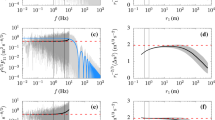Abstract
The capability of SODAR to measure the mean wind field in the lower boundary layer is well known and documented. Therefore, mean wind data are easily obtainable by means of the SODAR-technique, and are used to simulate the transport of pollutants after their release into the atmosphere. But when calculating the diffusion of pollutants, information about atmospheric turbulence is needed, too.
In principle, a SODAR can measure turbulence data like the standard deviation of the vertical wind speed or horizontal wind direction. But when measuring turbulence data with a SODAR, one is beset by a host of limitations like volume sampling, spatial and temporal separation of sampling volume, attenuation of the acoustic waves and the slow speed of sound. Therefore, successful turbulence measurements with SODAR are not numerous and little is known about the quality of these data.
In this context an intercomparison between a REMTECH-SODAR and a sonic anemometer mounted at the 100 m level of our meteorological tower was performed in summer 1990 at the Kernforschungszentrum Karlsruhe. The intercomparison is in two parts:
-
(1)
Half hour mean values of the standard deviation of the vertical wind speed are intercompared by scatter plots and by a linear regression and correlation analysis.
-
(2)
During 7 periods, 2 hours each, and covering atmospheric stabilities from unstable to slightly stable, the instantaneous vertical wind speeds were measured by both instruments and spectra were calculated.
The intercomparison demonstrates that DOPPLER-SODAR sounding is a reliable technique to determine besides the mean field, also athmospheric turbulence data like Sigma(w).
Similar content being viewed by others
References
Chintawongvanich P., Olsen R. and Biltoft C.A., 1989.Intercomparison of Wind Measurements from two Acoustic Doppler SODARs, a Laser Doppler Lidar, and In Situ Sensors. J. Atmos. Oceanic Technol., Vol. 6, 785–797.
Jenkins G.M. and Watts D.G., 1968.Spectral Analysis and Its Applications. San Francisco, Holden-Day.
Jones R.H., 1972.Aliasing with Unequally Spaced Observations. J. Appl. Met., Vol.11, No. 2, 245–254.
Kaimal J.C., Gaynor J.E., Finkelstein P.L., Graves M.E and Lockart T.J., 1984. An evaluation of Wind Measurements by Four Doppler SODAR. BAO Rep. No. 5, Wave Propagation Laboratory, NOAA/ERL, Boulder, CO, USA 110 pp.
Priestley M.B., 1981. Spectral Analysis and Time series. Volumes 1 and 2, Academic Press, New-York.
Thomas P. and Vogt S., 1990.Measurement of Wind Data by Doppler SODAR and tower Instruments: An Intercomparison. Meteorol. Rdsch., Vol. 42, 161–165.
Von Holleuffer-Kypke R., Hübschmann W.G., SüB F., Thomas P., 1984.Meteorologisches Informationssystem des Kernforschungszentrums Karlsruhe. Atomenergie, Kerntechnik, Vol. 44, No.4, 300–304.
Author information
Authors and Affiliations
Rights and permissions
About this article
Cite this article
Thomas, P., Vogt, S. Intercomparison of turbulence data measured by SODAR and sonic anemometers. Boundary-Layer Meteorol 62, 353–359 (1993). https://doi.org/10.1007/BF00705564
Received:
Issue Date:
DOI: https://doi.org/10.1007/BF00705564




